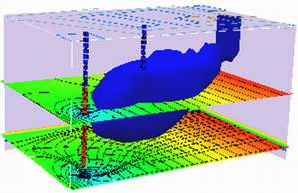F23 Exercise Set 3¶
LAST NAME, FIRST NAME
R00000000
Purpose :¶
Apply selected analytical models for reactive transport
Problem 1 (Problem 6-7, pg. 588)¶
An instantaneous release of biodegradable constituients occurs in a 1-D aquifer. Assume the mass released is \(1.0 ~kg\) over a \(10~m^2\) area normal to the flow direction, \(\alpha_l = 1.0~m\), the seepage velocity is 1.0 \(\frac{m}{day}\), and the half-life of the decaying constituient is 33 years.
Determine:
The maximum concentration at 100 meters from the source.
Plot a concentration history (annual intervals) for a 40 year period from release date for a location 100 meters from the source.
# sketch(s)
# list known quantities
# list unknown quantities
# governing principles
# solution details (e.g. step-by-step computations)
# discussion
Problem 2 (Problem 6-9, pg. 589)¶
An unintentional discharge from a point source introduced \(10~kg\) of contaminant mass to an aquifer. The seepage velocity is \(0.1~\frac{ft}{day}\) in the \(+x\) direction. The longitudinal dispersion coefficient is \(D_x = 0.01 \frac{ft^2}{day}\) the transverse dispersion coefficients are \(D_y = D_z = 0.001 \frac{ft^2}{day}\).
Determine:
Calculate the maximum concentration at \(x=100~ft\) and \(t=5~years\).
Calculate the concentration at \((x,y,z,t) = (200~ft,5~ft,2~ft,5~years)\)
# sketch(s)
# list known quantities
# list unknown quantities
# governing principles
# solution details (e.g. step-by-step computations)
# discussion
Problem 3 (Problem 6-10, pg. 589)¶
Apply the Domenico and Schwartz (1998) planar source model (pg. XXX) to a case of a continuous source that has been leaking contaminant into an aquifer for 15 years. The source had a width \(Y=6~m\) and depth \(Z=6~m\). The source concentration is \(10~\frac{mg}{l}\). The seepage velocity is \(0.057~\frac{m}{day}\). The longitudinal, transverse, and vertical dispervities are \(1~m\),\(0.1~m\), and \(0.01~m\) respectively.
Determine:
The contaminant concentration history at a location \(x=200~m\) from the source using 1-year increments for 30 years.
# sketch(s)
# list known quantities
# list unknown quantities
# governing principles
# solution details (e.g. step-by-step computations)
# discussion
Problem 4¶
The following table has data from a column test with bromide (conservative) and chromium (sorbed). The porosity of the soil was 0.485, the bulk density was 1.85 g/cc, velocity was 0.244 cm/min, and the column was 25.4 cm long with a diameter of 2.54 cm.
Time (min) |
Bromide \(\frac{C}{Co}\) |
Chromium \(\frac{C}{Co}\) |
|---|---|---|
0 |
0.000 |
0.000 |
15 |
0.000 |
0.000 |
30 |
0.005 |
0.000 |
45 |
0.003 |
0.000 |
60 |
0.013 |
0.000 |
75 |
0.075 |
0.000 |
90 |
0.137 |
0.000 |
105 |
0.530 |
0.000 |
120 |
0.841 |
0.000 |
135 |
1.000 |
0.000 |
150 |
1.000 |
0.000 |
165 |
1.000 |
0.009 |
180 |
1.000 |
0.186 |
195 |
1.000 |
0.595 |
210 |
1.000 |
0.791 |
225 |
1.000 |
0.875 |
240 |
1.000 |
0.913 |
255 |
1.000 |
0.946 |
270 |
1.000 |
0.946 |
285 |
1.000 |
1.000 |
300 |
1.000 |
1.000 |
315 |
1.000 |
1.000 |
330 |
1.000 |
1.000 |
345 |
1.000 |
1.000 |
360 |
1.000 |
1.000 |
Determine:
The dispersivity in cm
The retardation coefficient for \(Cr\).
# sketch(s)
# list known quantities
# list unknown quantities
# governing principles
# solution details (e.g. step-by-step computations)
# discussion
Problem 5¶
A batch isotherm test was performed with several 1-L solutions of the chemical of interest and one soil type, 20 g in each solution container. The initial and final solution concentrations are shown in the table. Fit the linear, Freundlich, and Langmuir isotherm equations to this data.
Initial Concentration (mg/L) |
Equilibrium Concentration (mg/L) |
|---|---|
7.10 |
6.71 |
4.53 |
4.18 |
1.89 |
1.63 |
1.31 |
1.10 |
1.03 |
0.85 |
Determine:
The Linear isotherm equation for these data (i.e. fit the isotherm model to the data), plot the isotherm and data
The Freundlich isotherm equation for these data, plot the isotherm and data
The Langmuir isotherm equation for these data, plot the isotherm and data
Which isotherm model produces the best fit for these data?
Show calculations and identify all fitted parameter values.
# sketch(s)
# list known quantities
# list unknown quantities
# governing principles
# solution details (e.g. step-by-step computations)
# discussion
